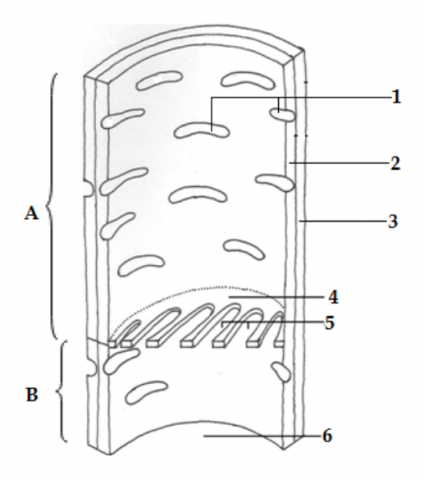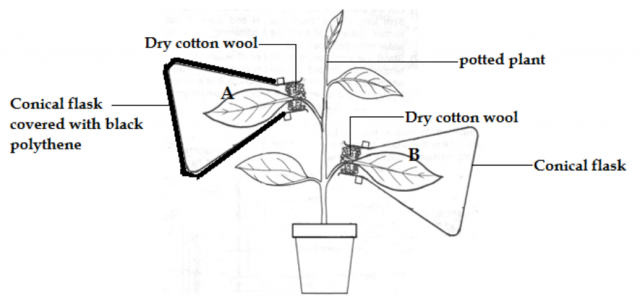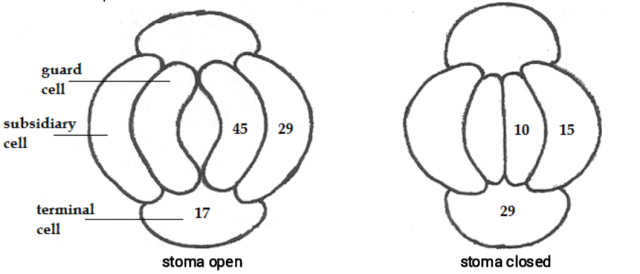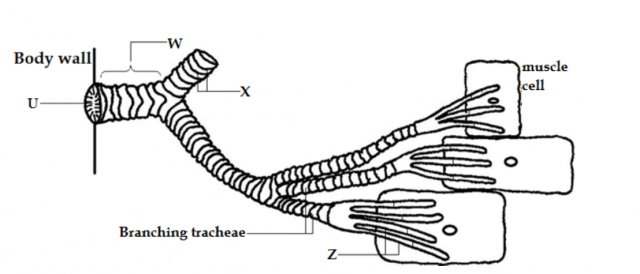KNEC KCSE Biology Paper 2 Question Paper / 2015 KCSE Starehe Boys Centre Mock
2015 KCSE Starehe Boys Centre Mock
Biology Paper 2
SECTION A (40 Marks)
Answer all questions in this section
In a breeding experiment involving garden peas and in which both parents were pure-breeding, plants with axial flowers were crossed with plants with terminal flowers. All the F1 plants had axial flowers. When the F1 plants were self-pollinated, a total of 858 seeds were produced in the F2 generation out of which 651 seeds gave rise to plants with axial flowers.
(a)
(i) Identify the recessive characteristic in the cross above (1 mark)
(ii) Give a reason for your answer in (a)(i) above (1 mark)
(b)Using the figures given above, work out the ratio of F2 plants with axial flowers to that of plants with terminal flowers (1 mark)
(c)
(i) Use a Punnett square to determine the genotypes of the F1 offspring (4 marks)
(ii)Work out the phenotypic ratio of the F2 offspring (1 mark)
8 marks
Illustrated below is a longitudinal section ofparts of two adjacent xylem cells, marked A and B. Study the illustration carefully and answer the questions that follow:
(a)Identify the xylem cells illustrated above (1 mark)
(b)
(i) Name the openings marked 1 and 5 and the structure marked 4 (3 marks)
(ii)Give one functional difference between the openings marked 1 and the openings marked 5
(1 mark)
(c)State one structural difference between the part of the cell marked 2 and the part marked 3
(1 mark)
(d)How does the part labelled 6 adapt the xylem cells to their function? (2 marks)
8 marks
In investigating a certain aspect of photosynthesis, two students at Starehe school set up the apparatus illustrated in the diagram below, using a potted Gallant soldier (Galinsoga parviflora) plant and which was growing in well-watered soil
The plant was first kept in darkness for 6 hours after which the experimental set up was exposed to sunlight for four hours. At the end of thistime period, the leaves labelled A and B were each tested for the presence of starch
(a)What was the aim of the experiment? (1 mark)
(b)Why was dry cotton wool rather than a rubber stopper used in the experiment? (1 mark)
(c)Why was the flask containing leaf A covered with black polythene paper? (1 mark)
(d)State the role of leaf B in the experiment (1 mark)
(e)
(i) What results were obtained in testing the leaves for starch? (2 marks)
Leaf A:
Leaf B:
(ii)Explain your answer in (e)(i) above (2 marks)
8 marks
(a) Illustrated below are parts of two plant species A and B. Study the illustrations carefully and
answer the questions that follow
(i)Give the terms used to describe the root systems illustrated in the diagrams above
(2 marks)
A
B
(ii)A student made cross sections of the roots of plant specimens A and Band observed these under a microscope. State two differences that the student would observe (2 marks)
(b)The diagram below illustrates the potassium ion (K+) concentration (in arbitrary units) in the cells around an open and a closed stoma of Tradescantia. Study the illustration carefully and answer the questions that follow
(i)Explain how the movement of potassium ions accounts for the closure of stomata
(3 marks)
(ii)Aside from the potassium ion mechanism described in (b)(i) above, name one other theory used to explain the opening and closing of stomata (1 mark)
8 marks
Carefully study the illustration of the parts of the gas exchange structures of a grasshopper shown below and answer the questions that follow:
(a)Identify and on the diagram, name the parts labelled W, X and Z (3 marks)
(b)Give one function of the structures labelled X (1 mark)
(c)Outline two adaptive features of the structures labelled Z (2 marks)
(d)Other than the hair-like structures, name one other structure found at the part labelled U
(1 mark)
(e)In what way is the gas exchange system in the diagram above more efficient than that found in mammals? (1 mark)
8 marks
SECTION B (40 Marks)
Answer question 6 (compulsory) and either question 7 or 8 in the spaces provided.
(a) Give two reasons why Tsetse flies are of economic importance (2 marks)
(b)In an experiment at ICIPE- Kenya, the survival rate of pupae of two species of Tsetse fly- Glossina morsitans and Glossina palpalis was studied. In both species, the pupae develop buried underground in soil. The results of this experiment were as shown in the table below:
(i)Suitably represent the data above on the graph paper provided (7 marks)
(ii)From the results of this experiment, deduce the respective habitats of the two species of Glossina
G. morsitans (1 mark)
G. palpalis (1 mark)
(iii)Explain your answers in (b)(ii) above
G. morsitans (2 marks)
G. palpalis (2 marks)
(iv)What results would have been obtained if the experiment had been carried out at a soil relative humidity of 90%? (2 marks)
(iv)What is the optimum soil humidity for survival of the pupa of the two species?
(2 marks)
G. morsitans
G. palpalis
(v)Explain the results obtained, for Glossina palpalis, at soil relative humidity beyond 78%
(2 marks)
21 marks
(a)Outline the adaptive features of the intestinal villi of mammals to their function
(7 marks)
(b)Describe the human menstrual cycle clearly specifying the roles of the hormones involved in the cycle (13 marks)
20 marks
(a) Describe the role of hormones in the development of insects that show incomplete
metamorphosis (10 marks)
(b) Describe the control of the rate of the heart beat in man (10 marks)
10 marks










